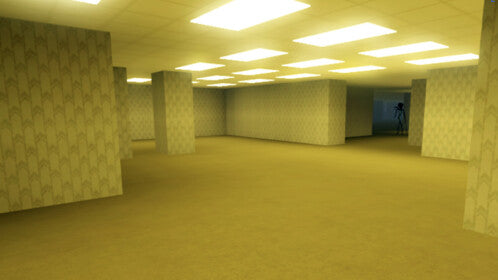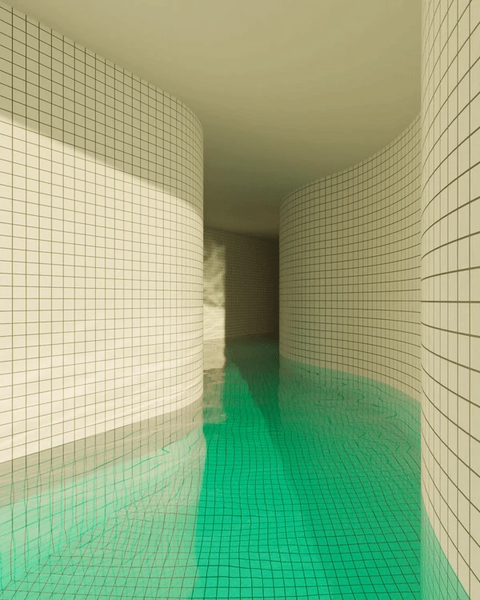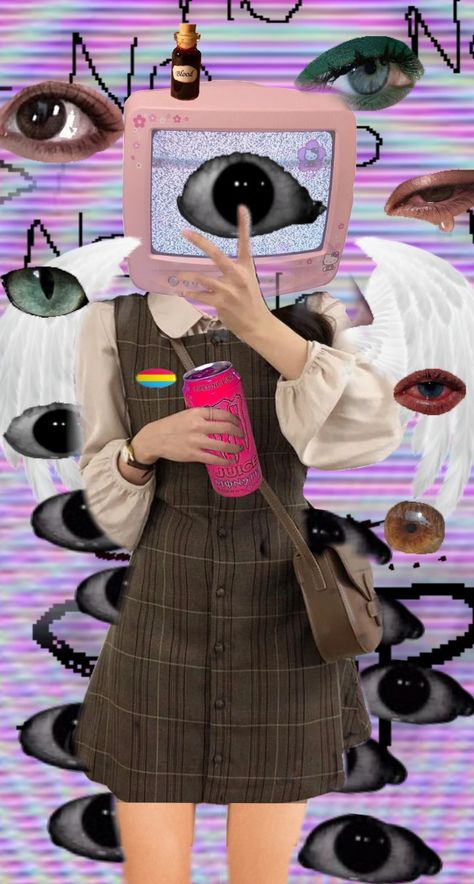

Liminal Space, Dreamcore, and Weirdcore.
A What tf, When tf, and why tf Breakdown
Big heads up.
This blog covers a few of the… weirdest, but coolest aesthetic movements in human history.
That’s definitely an oxymoron- I get it. But, these movements are an exploration of parts of our human mind that are hard to put into words. They play with the kind of creepy surreality that we find in the world of dreams and in places where time stands still.
That being said, I’ll be doing my best to be your guide as we jump into Liminal Spaces, Dreamcore, and Weirdcore. Three creepy but captivating, aesthetic movements that in recent times have SOMEHOW transfixed an entire subculture on the internet.
Liminal Space- What is it? Where did it Come From?

Liminal space is an aesthetic that’s centered around locations that are a transition between two spaces or states of being. The Latin root of the word, “Limen” literally translates to “threshold”. The space or state in between one thing and another, or one time and another.
So picture a school hallway or courtyard- but during summer. Still maintained, still clean, and still a “School”, yet somehow- it’s a husk of itself. It lacks any elements that give a school life. It’s a space in transition. The aesthetic tends to focus on spaces just like this; rest stops, waiting rooms, grocery stores, hallways and parking lots are some of the basic archetypes.

Essentially, these spaces when taken out of their functional context, i.e. being completely devoid of human life, transforms them from places where we’d meet and greet friends, to areas that stand on the edge of the unknown.
Of course, some editing motifs courtesy Vaporwave, Acidwave and Glitch have made their way into the space, which makes adding the “heebiejeebies” to any liminal space photo pretty simple.
As we’ll soon see in the original story of the Liminal Space aesthetic. The aim was initially to explore “disquieting” spaces from the safety of your screen. Some may find that photo of a vacant hospital waiting room nostalgic. Others -like myself- are promptly creeped out by it.
Liminal spaces give you the feeling that there’s something just “wrong” with the space. Similar to how you feel being outdoors late at night. If you’ve ever stopped for a smoke, at night, in a wooded area, you know what I mean. Or maybe you’ve been camping and had to answer nature’s call in the wee hours of the morning…
There’s “something” watching you- you just don’t know what it is.
That’s the feeling.
The edge of uncertainty.
The Sorta Creepy Origin Story
4Chan is the Internet’s universal home for creepy, gory, and all-around weird stuff. So it’s no surprise that Liminal spaces as an aesthetic can be traced back to it. On May 12th, 2019, an anonymous 4chan user posted a challenge to the board of /x/ paranormal to “post disquieting images that just feel off.”
That’s it-
The thread took off and over time edits from Vaporwave, Acidwave and Glitch became staple parts of the Liminal Space aesthetic, as they easily conveyed tones of “creepiness” that 4Chan users were looking for.
The Backrooms
The backrooms are what many would consider the pinnacle of the liminal space aesthetic. Inspired by a glitch in video games that allows players to exit the typical game space and enter into “backrooms” that allow them to traverse a space that exists outside of the intended function of the game.
Almost invariably, these spaces are creepy.

Often featuring glitched character models, lots of darkness, and random things that had been coded in previous versions of the game but weren’t intended for release, like lakes under a city, or locker rooms in the middle of a forest.
Backrooms have made their way into a variety of media, however, there’s actually a wiki that features fanmade backrooms that explore the liminal space concept in incredible detail. These creations are often infinitely vast in theory, with elements designed to inspire discomfort. Like a long undulating corridor, that has no end in sight, that’s also filled with toxic water with no way to escape…
Yeah- someone invested time into making that…
And I can’t lie.
As creepy as it feels to stare at, it’s pretty awesome. There’s one thing we can’t deny, about this entire movement and its offspring, Dreamcore and Weirdcore…
There is something utterly entrancing about liminal spaces, that’s hard to put your finger on. By their very nature, they suggest “transition” and “uncertainty”. They exist not for themselves, but solely as a space between one location or time and another.
There’s always a lingering sense of “who or what comes next?” Which I believe is the source of our fascination.
Here’s a sample, from Level 37 “Sublimity”

You can find this and other backroom examples on the wiki. There’s also a ton of liminal space content on TikTok.
Enjoy!
Dreamcore
No one really knows where Dreamcore came from.
At least, there isn’t an origin story that’s as traceable as Liminal Spaces. The aesthetic gained a significant amount of popularity in early 2020 when a series of visuals with disjointed, surreal, and “dreamlike” aesthetics started trending on TikTok.
Given how crazy 2020 was, and the number of people that suddenly found themselves isolated from society- maybe the origin of Dreamcore is self-explanatory.
The visuals seemed like the kind of thing you’d start hallucinating if you were isolated in total darkness for 72 hours. In many cases, these would feature characters that were “stitched together using a variety of images.” Most often, these characters would have objects for heads, even the ones that were clearly intended to be human, would have toasters, monitors, eyeballs, and other things instead of a head.

Inspired by Liminal Spaces
Dreamcore is effectively a surrealist aesthetic.
It’s centered around the kinds of imagery and motifs you might see in a dream. Shifting environments, vibrant, light colors, a “wavering” and ever-shifting reality interspersed with a variety of “random” features like eyeballs, wings, teeth, and a lot more that I can’t fit into this sentence.
Dreamcore is a lot like surreal memes, minus the reliance on absurdist humor.
Instead of “making a point” or telling a joke, Dreamcore is seemingly focused on simply emulating the experience of a dream as closely as possible. Hence the reliance on characters that you might see in a dream or a nightmare to tell a story.
Of course, there isn’t a NEED for characters, but they’re used pretty often, especially if there’s a story being told.

Nostalgia- but Uncomfortable
Dreamcore plays on that same feeling of familiar suspense that we get from themes in the Liminal Space aesthetic.
Often, the imagery used is centered around things we would have once seen in our childhood, but of course, warped so that our sense of nostalgia is intruded upon by a sense of unease.
Here’s one that hit a particularly creepy note for me.
I feel like, I’ve seen a lot of the imagery in late-night 90’s TV, cartoons, and video games. The juxtaposition of the upbeat music, and the lyrics that are obviously pointing toward your feelings of nostalgia take you on a creepy journey.
I’ve never done LSD, but I imagine this is what a bad trip looks like…
Weirdcore
Weirdcore is like the younger, creepier sibling of Dreamcore.
While Dreamcore does mostly inspire feelings of unease, you’re still able to find creations that err on the side of nostalgia and a simple appreciation of “dreamlike” states of consciousness.
You’ve got little to no hope of that once you venture into Weirdcore.
I’m not exaggerating…
The fanmade Wiki, defines weird core as: “a surrealist aesthetic centered around amateur or low-quality photography and/or visual images that have been constructed or edited to convey feelings of confusion, disorientation, dread, alienation, and nostalgia or anemoia.”
If you’ve never heard of the word “anemoia” don’t stress, it’s actually a term that was recently coined in -get this- “The Dictionary of Obscure Sorrows” and it means “nostalgia for a time you’ve never known.”
I think that about sums up the ethos of Weirdcore.
It’s dream core, but creepier, featuring an abundance of images that were once shared on a far more primitive Internet. In fact, Weirdcore creators set out to instill feelings of dread, for anyone who’s lived a childhood between the 90’s and 2000’s.
Think, 90’s to mid 2000’s lo-fi photography, with a splash of amateur editing and image compression- and probably some creepy music and you’ve got a good idea of Weirdcore.
Still lost?
Check this out.
@aasshley_anne id@kish #weirdcore #dreamcore #f #fyp ♬ original sound - noeli🧸🎀
Sure, it’s fun seeing Windows Media Player and reminiscing on the playlists you’d burn onto DVDs, but there’s no point to this story. Which in a way, is the point of Weirdcore. It’s not explicitly a horror-based genre, instead, creators rely on the lack of context and seemingly random assortment of creepy images to trick our brain into that sense of foreboding and dread.
Where did it Come From?
Much like Dreamcore, it’s hard to pin down an exact “starting point” for Weirdcore.
Some sources say, that it’s been around since 2010 in a variety of forms, which makes sense to me as a kid who grew up on the internet. I can think back to my teenage years and I’ve definitely seen some of the themes and motifs in modern Weirdcore, in the darker parts of early Internet.
At present, the earliest Weirdcore edit with a confirmed creation date was made in 2017.
A Youtube video by DavidCrypt who broke down the Weirdcore aesthetic can be credited with starting it’s upward trend in popularity. However, many of the most popular creators exist on Tumblr, a site that doesn’t show follower counts, so there may be a few creators who are missing out on credit here.

Tying it all Together
There’s always been a strange side of the internet and the upsurge of Liminal Space and related content isn’t surprising given the crazy few years we’ve had recently. If you’re interested in exploring feelings of anxiety or creepy things -as many of us are- you’ve probably just stumbled onto a treasure trove of binge-able content.
Be careful though.
Many Weirdcore and Dreamcore creators warn of feelings of depersonalization as a result of binging the content, so keep tabs on your mental state and consume in small bite-sized chunks. Especially from creators who make you feel more creepy than nostalgic.
All the best.
